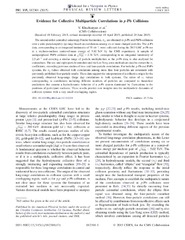Приказ основних података о документу
Evidence for Collective Multiparticle Correlations in p-Pb Collisions
| dc.creator | Khachatryan, V. | |
| dc.creator | Adžić, Petar | |
| dc.creator | Ekmedžić, Marko | |
| dc.creator | Milošević, Jovan | |
| dc.creator | Reković, Vladimir | |
| dc.creator | Đorđević, Miloš | |
| dc.creator | Milenović, Predrag | |
| dc.date.accessioned | 2018-03-01T16:15:44Z | |
| dc.date.available | 2018-03-01T16:15:44Z | |
| dc.date.issued | 2015 | |
| dc.identifier.issn | 0031-9007 | |
| dc.identifier.issn | 1079-7114 | |
| dc.identifier.uri | https://vinar.vin.bg.ac.rs/handle/123456789/634 | |
| dc.description.abstract | The second-order azimuthal anisotropy Fourier harmonics, nu(2), are obtained in p-Pb and PbPb collisions over a wide pseudorapidity (.) range based on correlations among six or more charged particles. The p-Pb data, corresponding to an integrated luminosity of 35 nb(-1), were collected during the 2013 LHC p-Pb run at a nucleon-nucleon center-of-mass energy of 5.02 TeV by the CMS experiment. A sample of semiperipheral PbPb collision data at root S-NN = 2.76 TeV, corresponding to an integrated luminosity of 2.5 mu b(-1) and covering a similar range of particle multiplicities as the p-Pb data, is also analyzed for comparison. The six-and eight-particle cumulant and the Lee-Yang zeros methods are used to extract the nu(2) coefficients, extending previous studies of two-and four-particle correlations. For both the p-Pb and PbPb systems, the nu(2) values obtained with correlations among more than four particles are consistent with previously published four-particle results. These data support the interpretation of a collective origin for the previously observed long-range (large..) correlations in both systems. The ratios of nu(2) values corresponding to correlations including different numbers of particles are compared to theoretical predictions that assume a hydrodynamic behavior of a p-Pb system dominated by fluctuations in the positions of participant nucleons. These results provide new insights into the multiparticle dynamics of collision systems with a very small overlapping region. | en |
| dc.relation | BMWFW (Austria), FWF (Austria), FNRS (Belgium), FWO (Belgium), CNPq (Brazil), CAPES (Brazil), FAPERJ (Brazil), FAPESP (Brazil), MES (Bulgaria), CERN, CAS (China), MoST (China), NSFC (China), COLCIENCIAS (Colombia), MSES (Croatia), CSF (Croatia), RPF (Cyprus), MoER (Estonia), ERC IUT (Estonia), ERDF (Estonia), Academy of Finland, MEC (Finland), HIP (Finland), CEA (France), CNRS/IN2P3 (France), BMBF, Germany, DFG (Germany), HGF (Germany), GSRT (Greece), OTKA (Hungary), NIH (Hungary), DAE (India), DST (India), IPM (Iran), SFI (Ireland), INFN (Italy), MSIP (Republic of Korea), NRF (Republic of Korea), LAS (Lithuania), MOE (Malaysia), UM (Malaysia), CINVESTAV (Mexico), CONACYT (Mexico), SEP (Mexico), UASLP-FAI (Mexico), MBIE (New Zealand), PAEC (Pakistan), MSHE (Poland), NSC (Poland), FCT (Portugal), JINR (Dubna), MON (Russia), RosAtom (Russia), RAS (Russia), RFBR (Russia), MESTD (Serbia), SEIDI (Spain), CPAN (Spain), Swiss Funding Agencies (Switzerland), MST (Taipei), ThEPCenter (Thailand), IPST (Thailand), STAR (Thailand), NSTDA (Thailand), TUBITAK (Turkey), TAEK (Turkey), NASU (Ukraine), SFFR (Ukraine), STFC (United Kingdom), DOE (U.S.), NSF (U.S.) | |
| dc.rights | openAccess | en |
| dc.rights.uri | https://creativecommons.org/licenses/by/4.0/ | |
| dc.source | Physical Review Letters | en |
| dc.title | Evidence for Collective Multiparticle Correlations in p-Pb Collisions | en |
| dc.type | article | en |
| dc.rights.license | BY | |
| dcterms.abstract | Миленовић Предраг; Милошевић Јован; Ђорђевић Милош; Кхацхатрyан, В.; Екмедзиц, М.; Рековиц, В.; Aдзиц, П.; | |
| dc.citation.volume | 115 | |
| dc.citation.issue | 1 | |
| dc.identifier.wos | 000357030500003 | |
| dc.identifier.doi | 10.1103/PhysRevLett.115.012301 | |
| dc.citation.other | Article Number: 012301 | |
| dc.citation.rank | M21a | |
| dc.identifier.pmid | 26182092 | |
| dc.contributor.count | CMS Collaboration (ukupan broj autora: 2152) | |
| dc.type.version | publishedVersion | |
| dc.identifier.scopus | 2-s2.0-84937926420 | |
| dc.identifier.fulltext | https://vinar.vin.bg.ac.rs//bitstream/id/13712/630.pdf |

